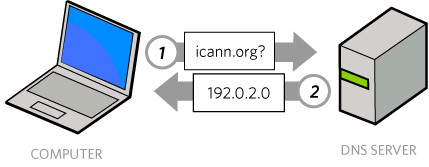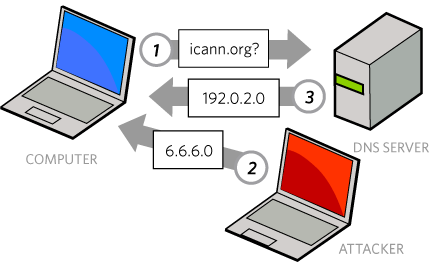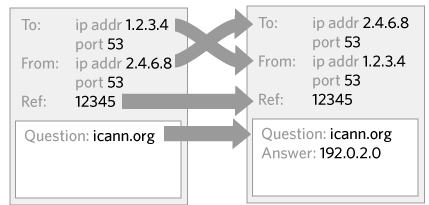


|
||
|
||
At ICANN’s meeting in Egypt last week, I had the opportunity to try and explain to various non-technical audiences why the Domain Name System (DNS) is vulnerable to attack, and why that is important, without needing a computer science degree to understand it. Here is the summary.
How does the DNS work?
The DNS can be considered to be a question-and-answer system. When you type in an address like “icann.org” into a web browser, your computer needs to turn that into a numeric address of the computer hosting that website. To do this, it sends a question over the Internet to a DNS server “Where is icann.org?” The DNS server sends back an answer, “The address is 192.0.2.0”.

How do you attack the DNS?
Let’s say I want to execute an attack on this question and answer exchange, in order to convince the computer to go to the wrong address. When the computer I wish to attack asks a question, my goal is to provide a fake response back to that computer quicker than the real server comes back with the response. By getting my forged answer back faster, the computer will proceed using my answer, rather than the official one.

So, if I send back a fake address to a computer, I can get that computer to go to a different address than the one intended. For example, on that address I might have set up a fake website intended to take someone’s sensitive data, like a replica of a bank’s website.
If I manage to attack one computer why is that a big deal?
A successful attack on one computer in isolation can be problematic for the user of that computer, but it is not that interesting to an attacker to succeed against only one person. Unlucky for us, just one successful attack can very easily have wider consequences. Let me explain.
The DNS is made much more efficient by the use of “caching” name servers. These name servers sit at ISPs, or on corporate networks, and perform DNS lookups on behalf of customers. It then stores the answers it receives in a cache, so for future lookups for the same domain it does not repeat the lookup—it just remembers the previous answer.
This means that if you execute an attack and it gets stored in a cache, it can actually impact many people over and over again, because that answer will be redistributed to everyone that uses that same caching server.
This is why this type of attack is usually called a “cache poisoning” attack, because by poisoning the cache with the wrong data, it creates a much more serious problem.
So I just send back an answer quicker, and that’s it?
It is not quite as simple as just sending a quicker answer back to a computer, you also have to guess certain attributes correctly on the answer that match the question. For example, your answer needs to go back to the same computer the question originated. You also need match the question that was being asked in your answer.

It is simple, however, to guess most of the attributes. As you know which computer you are trying to attack, you don’t need to guess that. As you know which domain you are trying to impersonate, that is also a given. Conventionally, there are only two variables. One variable is you need to guess which server the answer is coming from. The average domain on the Internet has around two or three name servers, only one of which will respond to any given query. Therefore you have about a one in three chance of guessing that correctly. The second variable is a unique reference number (formally, a “transaction ID”), that has about 65000 possibilities. Therefore you have about a 1 in 65000 chance of guessing that correctly.
Earlier this year, security researcher Dan Kaminsky found that it is devastatingly simple to exhaust all those possibilities in a very short amount of time by performing an attack in a certain way. How short? Well, British DNS researcher John Dickinson did some tests and found that on average he could successfully attack a server in just 1.3 seconds.
How do you fix the problem?
The sad news is there is no real solution as far as the regular DNS is concerned. It is not like a security hole in a piece of software that can be repaired with an update. This is an architectural flaw in the DNS protocol itself. There are patches for DNS software, but these only attempt to make executing an attack more difficult, they don’t solve the problem.
Some of the short term approaches to make attacks more difficult are as follows:
The net effect of these attempts to reduce the risk of attacks primarily involve adding more randomness for the attacker to guess. These approaches approximately double the number of “bits” of randomness. To be clear though, they only make an attack harder, but an attack is still viable. Furthermore, we know that both network speeds and computer speeds get faster and faster each year. These are the two things that slow down an attacker. Therefore, we know that successful attacks will just be easier and easier into the future.
If there is no short term solution, what is the long term solution?
While the DNS itself can’t be properly fixed for the security problem, a new protocol that overlays the DNS called DNSSEC does. DNSSEC uses a system of certification to show that a DNS answer has not been modified. If someone tries to execute an attack, the certificate won’t validate, and the incorrect answer will be thrown away.
DNSSEC is difficult to deploy. It requires upgrades in DNS servers, it changes the way domain name holders manage their name servers, and it adds extra complexity. However, with the knowledge that DNS attacks are so simple to execute without it, there is growing consensus that the pain it will take to deploy is less than the pain of a DNS that you can no longer trust.
More information
You can view the presentation slides used in Cairo.
Sponsored byDNIB.com

Sponsored byVerisign

Sponsored byIPv4.Global

Sponsored byWhoisXML API

Sponsored byVerisign

Sponsored byRadix

Sponsored byCSC

Glad you keep beating the drum. In 2004 we ran live demos of this technique at ICANN meetings - the SSAC folks took over in 2005 and early 2006. Hope there is better traction traction this pass, but its not new, exciting. The real trick is not signing the data - the real trick is how to manage the trust anchors in the end nodes - to date an unsolved problem.
Hello Kim Davies,
This is a lucid narrative of a complex technology. Articles like this would certainly help all the non-technical people who also help shape policy and programs. Please do write more.